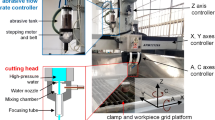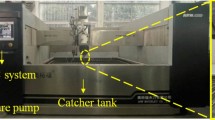Abstract
This study introduces the abrasive waterjet specific energy as a novel physical quantity to characterize the taper ratio in abrasive waterjet cutting. Said quantity was defined as a proper combination of the most influential control factors. A series of abrasive waterjet cutting experiments on aluminium 6082, were conducted, according to the design of experiments methodology. For each experimental run, the width of the kerf profile was measured and characterized in terms of taper ratio. The effect of the abrasive waterjet specific energy and the main process parameters on the measured quantities were investigated. Results showed that inside the experimental range of the process parameters, the abrasive waterjet specific energy correlates well with the taper ratio. As a conclusion, different combinations of the control factors (water pressure, abrasive mass flow rate, feed rate), corresponding to the same level of abrasive waterjet specific energy, produced the same cutting kerf geometry as well as the same taper ratio. This result gives freedom to the waterjet users in selecting the best parameter combination according to some criteria (e.g., time or cost) for achieving the target AWJ-specific energy and the consequent kerf quality.







Similar content being viewed by others
Data availability
The data that support the findings of this study are available on request from the corresponding author.
Abbreviations
- \(p\) MPa:
-
Water pressure
- \({d}_{{\text{n}}}\) mm:
-
Primary orifice diameter
- \(\rho\) kg∙m− 3 :
-
Water density
- \({v}_{{\text{th}}}\) m∙s− 1 :
-
Waterjet theoretical velocity
- \(n,L\) -, MPa:
-
Constants
- \({v}_{{\text{j}}}\) m∙s− 1 :
-
Real jet velocity
- \(\psi\) -:
-
Compressibility coefficient
- \({c}_{{\text{v}}}\) -:
-
Velocity coefficient
- \({c}_{{\text{d}}}\) -:
-
Discharge coefficient
- \({\dot{m}}_{{\text{w}}}\) kg∙s− 1 :
-
Water mass flow rate
- \({Q}_{{\text{w}}}\) m3∙s− 1 :
-
Water volume flow rate
- \({S}_{n}\) mm2 :
-
Nominal cross-sectional area of the orifice
- \({P}_{{\text{hydr}}}\) W:
-
Jet hydraulic power
- \({\dot{m}}_{{\text{a}}}\) kg∙min− 1 :
-
Abrasive mass flow rate
- \({d}_{{\text{f}}}\) mm:
-
Focuser tube diameter
- sod mm:
-
Standoff distance
- \({v}_{{\text{f}}}\) mm∙min− 1 :
-
Feed rate
- \({P}_{{\text{part}}}\) W:
-
Jet power
- \({E}_{{\text{sp}}}\) J∙mm− 1 :
-
Abrasive waterjet specific energy
- \(c\) J∙mm− 3 :
-
Material volume removed per unit energy
- \(h\) mm:
-
Sample thickness
- \(w\) mm:
-
Kerf width
- \({T}_{{\text{R}}}\) mm/mm:
-
Taper ratio
- \({w}_{{\text{r}}}(z)\) mm:
-
Right side of the kerf profile
- \({w}_{{\text{l}}}(z)\) mm:
-
Left side of the kerf profile
- \({w}_{{\text{p}}}\left(z\right)\) mm:
-
Half kerf profile
- \({\overline{w} }_{{\text{p}}}\left(z\right)\) mm:
-
Average half kerf profile
References
Momber AW, Kovacevic R (1998) Principles of abrasive water jet machining. Springer, London
Monno M, Annoni M, Ravasio C (2007) Water jet, a flexible technology. Polipress, Milano
Liu X, Liang Z, Wen G, Yuan X (2019) Waterjet machining and research developments: a review. Int J Adv Manuf Technol 102(5–8):1257–1335. https://doi.org/10.1007/s00170-018-3094-3
Wang J (2003) The effect of jet impinging angle on the cutting performance in AWJ machining of alumina ceramics. Key Eng Mater 238–239:117–122
Llanto JM, Tolouei-Rad M, Vafadar A, Aamir M (2021) Recent progress trend on abrasive waterjet cutting of metallic materials: a review. Appl Sci 11(8):3344. https://doi.org/10.3390/app11083344
Li H, Wang J (2015) An experimental study of abrasive waterjet machining of Ti-6Al-4V. Int J Adv Manuf Technol 81(1–4):361–369. https://doi.org/10.1007/s00170-015-7245-5
Ay M, Çaydaş U, Hasçalik A (2010) Effect of traverse speed on abrasive waterjet machining of age hardened Inconel 718 nickel-based superalloy. Mater Manuf Process 25(10):1160–1165. https://doi.org/10.1080/10426914.2010.502953
Llanto JM, Vafadar A, Aamir M, Tolouei-Rad M (2021) Analysis and optimization of process parameters in abrasive waterjet contour cutting of AISI 304L. Metals 11(9):1362. https://doi.org/10.3390/met11091362
Rokosz K (2022) Surface engineering of metals and alloys. Metals 12(4):542. https://doi.org/10.3390/met12040542
Llanto JM, Tolouei-Rad M, Vafadar A, Aamir M (2021) Impacts of traverse speed and material thickness on abrasive waterjet contour cutting of austenitic stainless steel AISI 304L. Appl Sci 11(11):4925. https://doi.org/10.3390/app11114925
Perec A (2018) Experimental research into alternative abrasive material for the abrasive water-jet cutting of titanium. Int J Adv Manuf Technol 97(1–4):1529–1540. https://doi.org/10.1007/s00170-018-1957-2
Ishfaq K, Ahmad Mufti N, Ahmed N, Pervaiz S (2019) Abrasive waterjet cutting of cladded material: kerf taper and MRR analysis. Mater Manuf Process 34(5):544–553. https://doi.org/10.1080/10426914.2018.1544710
Unde PD, Gayakwad MD, Patil NG, Pawade RS, Thakur DG, Brahmankar PK (2015) Experimental investigations into abrasive waterjet machining of carbon fiber reinforced plastic. J Compos 2015:1–9. https://doi.org/10.1155/2015/971596
Doreswamy D, Shivamurthy B, Anjaiah D, Sharma NY (2015) An investigation of abrasive water jet machining on graphite/glass/epoxy composite. Int J Manuf Eng 2015:1–11. https://doi.org/10.1155/2015/627218
Sambruno A, Bañon F, Salguero J, Simonet B, Batista M (2019) Kerf taper defect minimization based on abrasive waterjet machining of low thickness thermoplastic carbon fiber composites C/TPU. Materials 12(24):4192. https://doi.org/10.3390/ma12244192
Srinivasu DS, Axinte DA, Shipway PH, Folkes J (2009) Influence of kinematic operating parameters on kerf geometry in abrasive waterjet machining of silicon carbide ceramics. Int J Mach Tools Manuf 49(14):1077–1088. https://doi.org/10.1016/j.ijmachtools.2009.07.007
Tiwari T et al (2018) Parametric investigation on abrasive waterjet machining of alumina ceramic using response surface methodology. IOP Conf Ser: Mater Sci Eng 377:012005. https://doi.org/10.1088/1757-899X/377/1/012005
Dugar J, Ikram A, Pušavec F (2021) Comparative characterization of different cutting strategies for the sintered ZnO electroceramics. Appl Sci 11(20):9410. https://doi.org/10.3390/app11209410
Hamatani G, Ramulu M (1990) Machinability of high temperature composites by abrasive waterjet. J Eng Mater Technol 112(4):381–386. https://doi.org/10.1115/1.2903346
Hashish M (2014) Kinetic power density in waterjet cutting. In: Proceeding of BHR Group - 22nd International Conference on Water Jetting
Hashish M (1989) Pressure effects in abrasive-waterjet (AWJ) machining. J Eng Mater Technol 111(3):221–228. https://doi.org/10.1115/1.3226458
Perotti F, Annoni M, Calcante A, Monno M, Mussi V, Oberti R (2021) Experimental study of abrasive waterjet cutting for managing residues in no-tillage techniques. Agriculture 11(5):392. https://doi.org/10.3390/agriculture11050392
Perotti F, Mossini E, Macerata E, Annoni M, Monno M (2023) Applicability of abrasive waterjet cutting to irradiated graphite decommissioning. Nucl Eng Technol 55(7):2356–2365. https://doi.org/10.1016/j.net.2023.03.026
Wang S, Zhang S, Wu Y, Yang F (2017) Exploring kerf cut by abrasive waterjet. Int J Adv Manuf Technol 93(5–8):2013–2020. https://doi.org/10.1007/s00170-017-0467-y
Wang S, Hu D, Yang F, Lin P (2022) Research on kerf error of aluminum alloy 6061–T6 cut by abrasive water jet. Int J Adv Manuf Technol 118(7–8):2513–2521. https://doi.org/10.1007/s00170-021-08056-5
Arola D, Ramulu M (1996) A study of kerf characteristics in abrasive waterjet machining of graphite/epoxy composite. J Eng Mater Technol 118(2):256–265. https://doi.org/10.1115/1.2804897
Ma C, Deam RT (2006) A correlation for predicting the kerf profile from abrasive water jet cutting. Exp Thermal Fluid Sci 30(4):337–343. https://doi.org/10.1016/j.expthermflusci.2005.08.003
Wang S, Zhang S, Wu Y, Yang F (2017) A key parameter to characterize the kerf profile error generated by abrasive water-jet. Int J Adv Manuf Technol 90(5–8):1265–1275. https://doi.org/10.1007/s00170-016-9402-x
Uthayakumar M, Khan MA, Kumaran ST, Slota A, Zajac J (2016) Machinability of nickel-based superalloy by abrasive water jet machining. Mater Manuf Process 31(13):1733–1739. https://doi.org/10.1080/10426914.2015.1103859
Thakur RK, Singh KK (2020) Experimental investigation and optimization of abrasive water jet machining parameter on multi-walled carbon nanotube doped epoxy/carbon laminate. Measurement 164:108093. https://doi.org/10.1016/j.measurement.2020.108093
Copertaro E, Perotti F, Castellini P, Chiariotti P, Martarelli M, Annoni M (2020) Focusing tube operational vibration as a means for monitoring the abrasive waterjet cutting capability. J Manuf Process 59:1–10. https://doi.org/10.1016/j.jmapro.2020.09.040
Copertaro E, Perotti F, Annoni M (2021) Operational vibration of a waterjet focuser as means for monitoring its wear progression. Int J Adv Manuf Technol 116(5–6):1937–1949. https://doi.org/10.1007/s00170-021-07534-0
Copertaro E, Annoni M (2022) Airborne acoustic emission of an abrasive waterjet cutting system as means for monitoring the jet cutting capability. Int J Adv Manuf Technol 123(7–8):2655–2667. https://doi.org/10.1007/s00170-022-10317-w
Funding
This research received no external funding.
Author information
Authors and Affiliations
Contributions
F.P conceived the conceptualization and the methodology, designed and performed the experiments and wrote the paper. M.A conceived the research and supervised and reviewed the manuscript. M.M performed the proofreading of the paper.
Corresponding author
Ethics declarations
Competing interests
The authors no competing interests.
Additional information
Publisher's Note
Springer Nature remains neutral with regard to jurisdictional claims in published maps and institutional affiliations.
Rights and permissions
Springer Nature or its licensor (e.g. a society or other partner) holds exclusive rights to this article under a publishing agreement with the author(s) or other rightsholder(s); author self-archiving of the accepted manuscript version of this article is solely governed by the terms of such publishing agreement and applicable law.
About this article
Cite this article
Perotti, F., Monno, M. & Annoni, M. Investigation of the influence of the AWJ-specific energy on the cutting kerf profile on aluminium 6082. Int J Adv Manuf Technol 130, 2799–2809 (2024). https://doi.org/10.1007/s00170-023-12841-9
Received:
Accepted:
Published:
Issue Date:
DOI: https://doi.org/10.1007/s00170-023-12841-9




